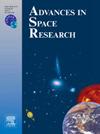Correlating sunspot numbers with Alfvén and Magnetosonic Mach number across last four solar cycles and prediction of solar cycle 25 with LSTM+model
IF 2.8
3区 地球科学
Q2 ASTRONOMY & ASTROPHYSICS
引用次数: 0
Abstract
Solar activity dynamics are explored through an in-depth analysis of the interplay between sunspot numbers and critical magnetohydrodynamic parameters − specifically Alfvén Mach number and Magnetosonic Mach number − over the past four solar cycles (SC). Our investigation reveals a robust negative correlation between SSN and both Alfvén Mach number and Magnetosonic Mach number, shedding light on the intertwined nature of solar magnetic phenomena and magnetohydrodynamic processes. Significant temporal synchronicities are unveiled, elucidating compelling alignments between specific features of Alfvén Mach number and Magnetosonic Mach number and the peaks and troughs of SSN throughout the solar cycles. This temporal coherence underscores the complex interplay between solar magnetic activity and the broader dynamics of magnetohydrodynamic phenomena, providing deeper insights into solar cycle behavior. To enhance our understanding and predictive capabilities, we deploy an optimized LSTM+model for forecasting Alfvén Mach number and Magnetosonic Mach number in the ongoing solar cycle, SC-25. Rigorous validation of the model’s accuracy is achieved through meticulous examination of prediction results for SC-24, affirming the reliability and robustness of our predictive framework. Furthermore, the anticipated timing of the first appearance to peak and the overall peak of SSN in SC-25 is calculated as 2 Jun. 2023 ± 34 days and 16 Jan. 2025 ± 27 days, respectively. Notably, these projections suggest the possibility of a double peak phenomenon in SC-25, characterized by comparable intensity levels around 160.
将过去四个太阳周期的太阳黑子数与阿尔弗文和磁子马赫数相关联,并利用 LSTM+ 模型预测太阳周期 25
通过深入分析过去四个太阳周期(SC)中太阳黑子数与关键磁流体动力学参数(特别是阿尔弗文马赫数和磁声波马赫数)之间的相互作用,探索了太阳活动动力学。我们的研究揭示了太阳黑子数与阿尔弗文马赫数和磁声波马赫数之间强烈的负相关,揭示了太阳磁现象和磁流体动力学过程相互交织的本质。揭示了重要的时间同步性,阐明了阿尔弗文马赫数和磁声波马赫数的特定特征与整个太阳周期中 SSN 的峰值和谷值之间令人信服的一致性。这种时间上的一致性强调了太阳磁活动与更广泛的磁流体动力学现象之间复杂的相互作用,为我们更深入地了解太阳周期行为提供了依据。为了加强我们的理解和预测能力,我们部署了一个优化的 LSTM+ 模型,用于预测正在进行的太阳周期 SC-25 中的阿尔弗文马赫数和磁流体马赫数。通过细致检查 SC-24 的预测结果,对模型的准确性进行了严格验证,从而肯定了我们预测框架的可靠性和稳健性。此外,根据计算,SC-25 中 SSN 首次出现峰值和总体峰值的预期时间分别为 2023 年 6 月 2 日 ± 34 天和 2025 年 1 月 16 日 ± 27 天。值得注意的是,这些预测表明,SC-25 有可能出现双峰现象,其特点是强度水平在 160 左右。
本文章由计算机程序翻译,如有差异,请以英文原文为准。
求助全文
约1分钟内获得全文
求助全文
来源期刊

Advances in Space Research
地学天文-地球科学综合
CiteScore
5.20
自引率
11.50%
发文量
800
审稿时长
5.8 months
期刊介绍:
The COSPAR publication Advances in Space Research (ASR) is an open journal covering all areas of space research including: space studies of the Earth''s surface, meteorology, climate, the Earth-Moon system, planets and small bodies of the solar system, upper atmospheres, ionospheres and magnetospheres of the Earth and planets including reference atmospheres, space plasmas in the solar system, astrophysics from space, materials sciences in space, fundamental physics in space, space debris, space weather, Earth observations of space phenomena, etc.
NB: Please note that manuscripts related to life sciences as related to space are no more accepted for submission to Advances in Space Research. Such manuscripts should now be submitted to the new COSPAR Journal Life Sciences in Space Research (LSSR).
All submissions are reviewed by two scientists in the field. COSPAR is an interdisciplinary scientific organization concerned with the progress of space research on an international scale. Operating under the rules of ICSU, COSPAR ignores political considerations and considers all questions solely from the scientific viewpoint.
 求助内容:
求助内容: 应助结果提醒方式:
应助结果提醒方式:


